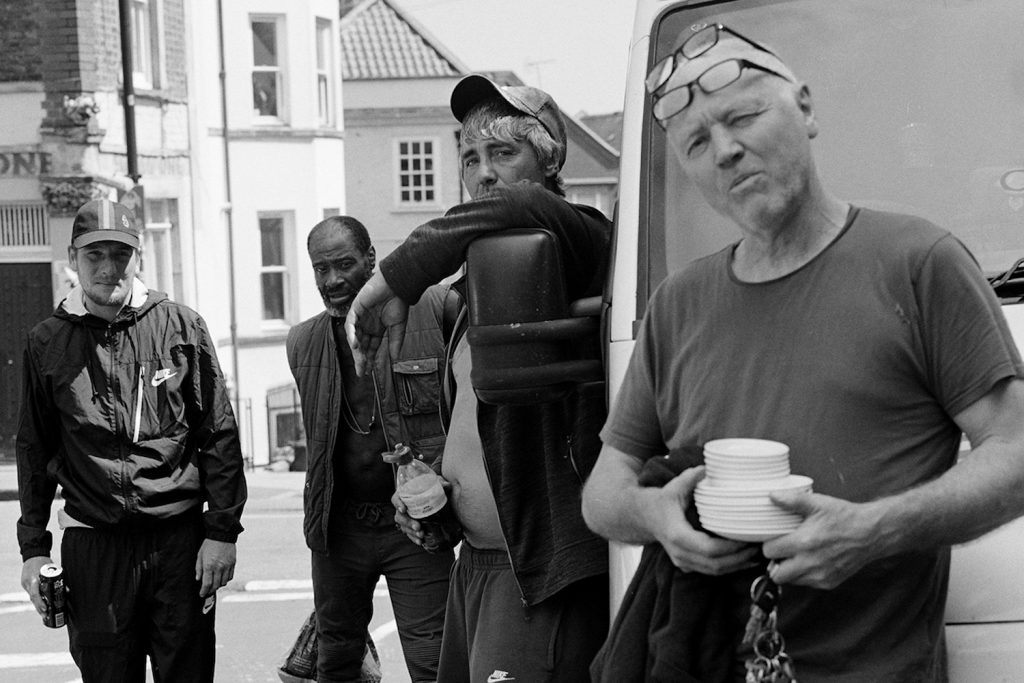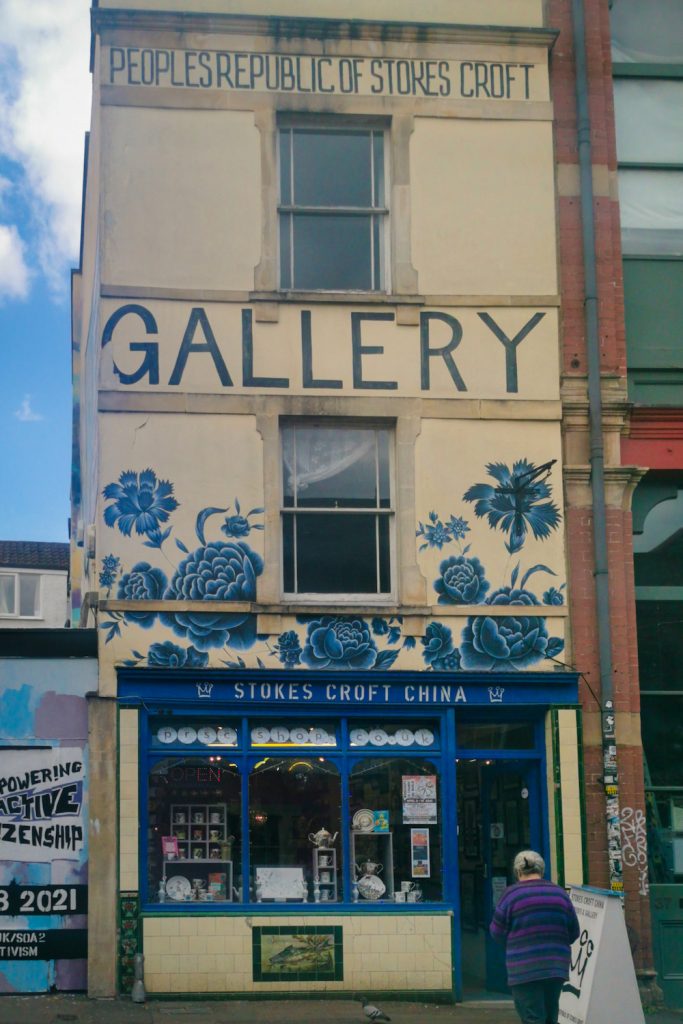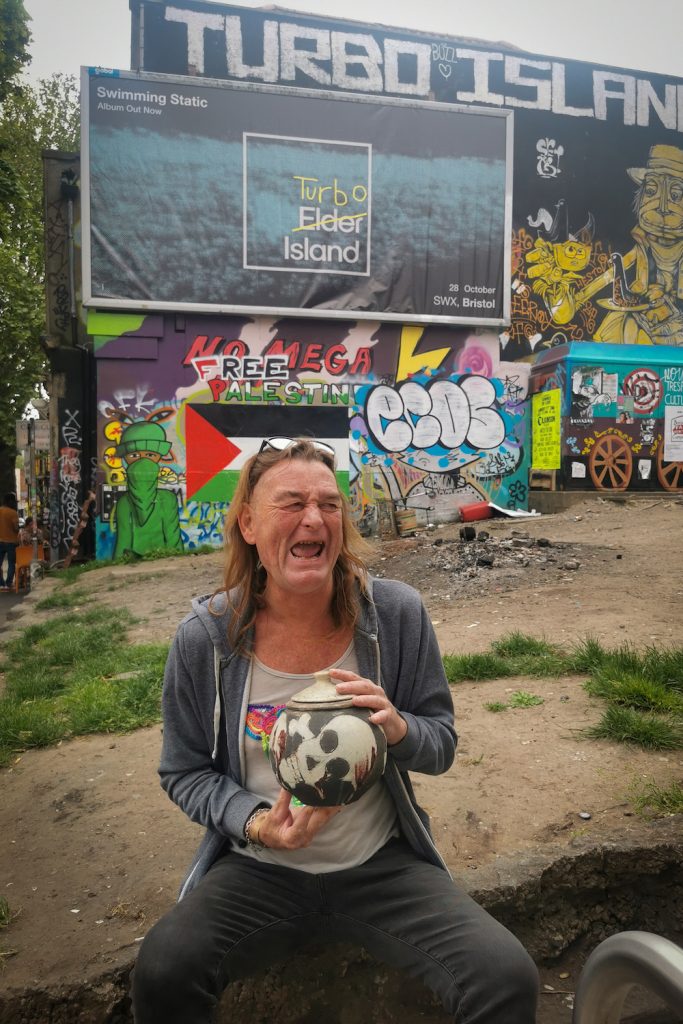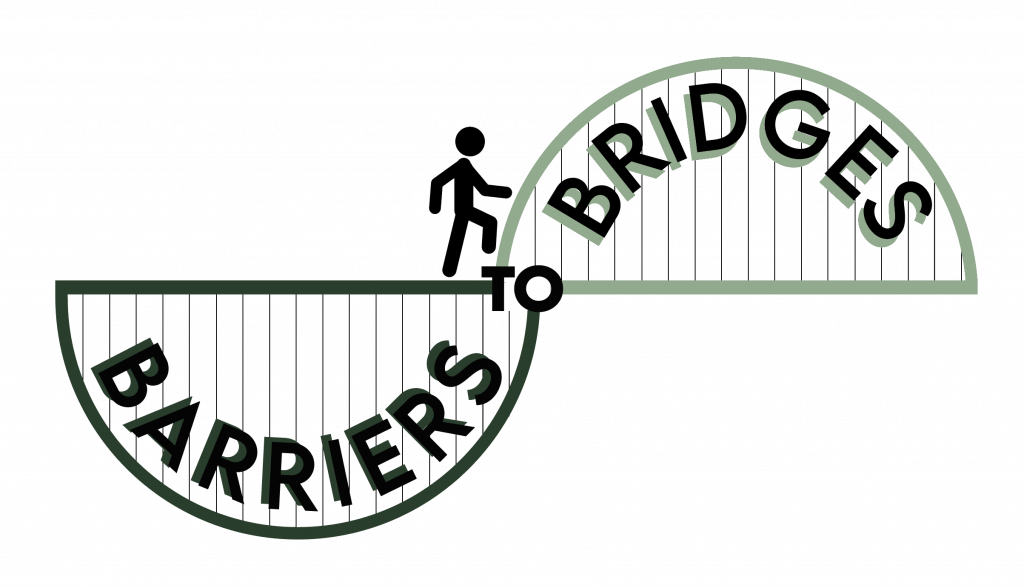by Dawn M. Sanders
Gentrification is everywhere. In most larger towns and cities, gentrification, alongside the hallmark of capitalism creates a cloned atmosphere, where you could be anywhere, as community has become a fragmented thing of the past. Homelessness too is everywhere, as people are squeezed out from one social circumstance to the next, so any thriving effort to keep community alive – putting human wellbeing before profit, stands out.
Are you allowed to do that? “I should think so, it’s our wall.” Chris Chalkley.

Most major cities are a tail of two, with London’s grey veneer, Sheffield’s post-industrial sprawl or the menacing vibe once described to me by a friend as she exited Birmingham New Street train station. However the ages-old class and cultural divide in the twenty-first century, with political and economic polarisation laid bear, whether from austerity or now the covid-19 pandemic, the upshot is a cultural war as rampant as the virus itself.
I first heard of the People’s Republic of Stokes Croft (PRSC) while visiting a friend in Bristol. I eventually got the phone number, made the connection and went to see them.
The unique enclave of independent shops and street art of Stokes Croft, has a long history of post-industrial dereliction, yet a creative soul as unbreakable as the bricks of the buildings themselves. Entering the area is like entering Brighton or London’s Camden Town 25 years ago, with its colourful facades and funky, quaint shops.
Stokes Croft China shop, formerly an old chippy, now a social enterprise to what is described as a kind of factory shop, where street art is replicated onto plain china brought in. Most of the shop or online sales go to homeless projects or community grassroots initiatives, as PRSC has its fingers in several pies. There are kilns available, art spaces for local creatives, a small library of radical literature and room for events to help raise money, as the project has expanded to a larger building adjacent to the china shop, with a yard in between behind the monthly-changing mural wall.


Great beginnings
Chris Chalkley, who founded the project in 2007, came from trading in ceramics in Staffordshire. When the trade declined and became untenable, he moved into street art – moving to Bristol with left over capital of his business. Dan Hart, who became involved through his experience of running events, activism, record shops and his own creativity in screen prints, describes the founder: “incredible artist, creates a lot of ceramic pieces and graffiti, he is trying to keep Stokes Croft independent.” In moving to Bristol, Chalkley witnessed an ongoing battle with graffiti artists and the will of the council: “one day there would be a bit of nice graffiti art, the next day it would be painted over.” As they bought some land on derelict patches, back in 2006 he painted a Christmas mural, with black smoke Santas depicting slaves, coming out of the chimney. Chalkley described people asking: “are you allowed to do that?. And I said, I should think so, it’s our wall. During the 2 days of painting that mural, it became apparent, the role of the state in the city was to stop people from doing stuff.” That mural wall has since been painted over 143 times, reflecting political circumstances or local sentiment. Chalkley and collaborators wanted to create an outdoor gallery and conservation area.
Tesco and the Riots
Community versus corporation is nothing new in modern times, but when the tug-of-war is played out on city streets as they did during the 2011 riots, alarm bells should be ringing in the ears of the architects of capitalism and those who keep it afloat that, something is badly wrong and not working…
Chalkley spoke of how the planning permission application for Tesco, bordering Stokes Croft, an independent area, was put through covertly and didn’t consult members of the community. It was really late-in-the-game that the community got the news that it would be built after 50 letters were sent to the council with no response. There was a grassroots campaign to keep Tesco out of Stokes Croft and 300 people went to the protest. However, the council sided with Tesco over the community, which is why there were riots, as every effort was made to block people out and away from protesting. To this day there are local animosities and people that still refuse to shop at the Tesco a stone’s throw from the PRSC.
Places and Spaces
The Bear Pit, or St James Barton roundabout, is one of a couple of cultural anomalies connected with PRSC or Bristol’s wider unique cultural heritage. As the above article points out, the PRSC were deeply involved in keeping the Bear Pit a creative community space however, according to Chalkley in 2019, the council brought in private security and removed PRSC’s contributions of creativity to the space. Benoit Bennett, who has volunteered with PRSC for ten years and is now a director, said: “Talking about the Bear Pit, which is now very bare, after spending so many years encouraging people to paint it all over, it was so colourful and people there all the time. All the subways are magnolia now and painted with anti-graffiti paint, there’s lots of wider issues around that.” Unfortunately, Bristol City Council were unattainable for commenting on its relations with PRSC.
Another spot of significance is Turbo Island – a derelict bit of scrubland, just yards from the china shop. With an equally interesting history, Chalkley tells the story of how there was a shoe shop there, which was destroyed during the 2nd World War, then it was abandoned for decades. 5 years after Stokes Croft was declared an area of conservation, the council sold it to a billboard company in 1985. The billboard company had no real interest in it, so PRSC just use it. “At the time it was named, Turbo cider was the cheapest white cider that could be bought and that’s why it’s called Turbo Island.” – Chalkley said, stressing the police have no jurisdiction over it as it is private land and now serves as a hangout for local homeless people.
My assistant/illustrator and I spent around half an hour to 45 minutes or so hanging out with them, as they were so willing to share their stories. Tim Blackshaw told of how he had obtained an art degree at Camberwell Art College, but has been homeless for years. “The cops beat the f*cking shit out of me, when I went to the poll tax riots.” As he went onto describe debilitating arthritis – leaning on a stick he made of cherrywood. As ravey music blasted from a speaker against the traffic of the nearby road, I got a sense, it was their pub, yet anyone’s space. “We, are the people.” Blackshaw said.

Meanwhile, the PRSC has a blanket and coat exchange and at the time of interview, Dan Hart spoke of a healthy meal provided every day via the food project – for either those who could not afford to pay or who could pay what they could. Outside the building they have a tap available to anyone needing water and are a focal point just for people to drop in, share in the tea and cake politics or feel a part of something if lonely.
On the wider issue of homelessness, Hart said: “There’s a tendency to move people from one area to another, instead of looking at the root cause. Everyone has different reasons for being on the street. Instead of finding solutions, the system gentrifies it, sterilises it, moves them out.” The project brings people together with political comedy nights, spaces for debate and were a lifeline at the height of lockdown.
Places supposed to help homeless people, closed, and protecting people from the virus meant lack of access to a bed. Bennett said: “I think in the beginning, getting Everybody In, making sure local authorities had money to house people, brought homelessness to people’s attention. Maybe it changed the public’s attitude, but that hasn’t continued. The next lockdown, schemes were not reinstated.” He continued, saying “just giving someone who lives on the street and has addiction problems a room to stay in for however long is not helpful and they need a lot more support”. While there is often community out on the street, often for those living alone or rehoused into a lack of community, carries its own consequences.
PRSC also help distribute the DOPE Magazine, much like the Big Issue, for people to sell, make a little extra money and gain credibility on the street.
Lockdown or not, as people retreat into their comfort zones or safe havens (for those of us that have one) to protect themselves or one another from the world, whether living indoors or out, it could be said community centres and projects up and down the country are a lifeline for human connection. As neighbourhood community has largely died out, community centres, whether a café, pub, disused church or purpose-build centre, they are the remaining viz of collectivism in many different forms. Whether Brighton Unemployed Centre, St Sidwell Community Centre, Exeter or Shettleston Community Centre in Glasgow they are usually run by people who give a toss. However, the PRSC go the extra mile in keeping out big corporation, in the name of creativity, community and autonomy.
© 2021

What an inspiring an enlightening article! So much hope created by the power of people and a community.